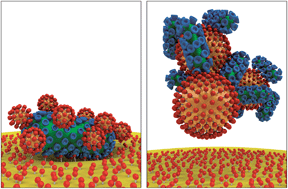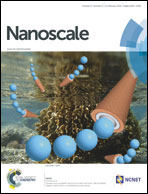Virus inhibition induced by polyvalent nanoparticles of different sizes†
Abstract
The development of antiviral agents is one of the major challenges in medical science. So far, small monovalent molecular drugs that inhibit the late steps in the viral replication cycle, i.e., virus budding, have not worked well which emphasizes the need for alternative approaches. Polyvalently presented viral receptors, however, show potential as good inhibitors of virus–cell binding, which is the first step in the viral infection cycle. By gradually increasing the size of ligand functionalized gold nanoparticles, up to virus-like dimensions, we are now able to quantify the polyvalent enhancement of virus–cell binding inhibition and to identify varying mechanisms of virus inhibition with different efficacies: by employing a new binding assay we found that surface area-normalized polysulfated gold nanoparticles of diameters equal to and larger than the virus diameter (>50 nm) more efficiently inhibit the binding of vesicular stomatitis virus (VSV) to cells than smaller particles. On a per particle basis, larger sized gold nanoparticles were surprisingly shown to inhibit the viral infection up to two orders of magnitude more efficiently than smaller particles, which suggests different mechanisms of virus inhibition. Based on complementary electron microscopic data, we noticed that larger gold nanoparticles act as efficient cross-linkers between virions, whereas smaller gold nanoparticles decorate the surface of individual virus particles. Our systematic study accentuates the need for the design of biodegradable, virus-sized inhibitors capitalizing on polyvalent binding.


 Please wait while we load your content...
Please wait while we load your content...